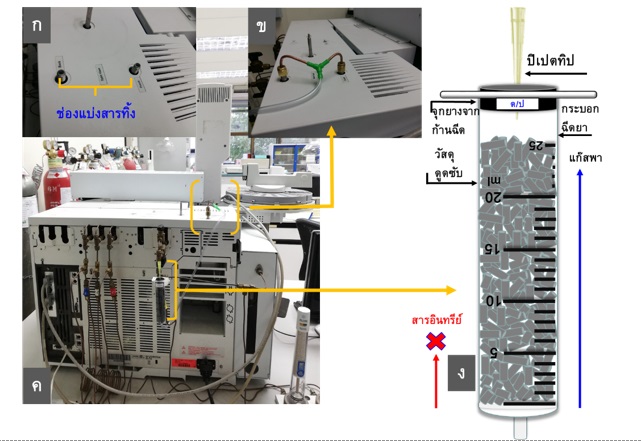Cost-effective device for split vent trap organic compounds from gas chromatograph
Keywords:
Organic solvent, Activated carbon, Split vent trap, Gas chromatographAbstract
Since, the problem of volatile organic matter split vent from the gas chromatograph, affecting the health of workers, lead to the invention of adsorption device for volatile organic matter that split from front and back of gas chromatograph, using in laboratories. The adsorption device includes a syringe containing the used activated carbon. In this work the device was studied under actual working conditions. Absorption efficiency of the device for heptane and dichloromethane adsorption were found as 99.51% - 99.98% and 96.68% - 99.35% respectively. The number of times that it can be reused is 10 with 7 months life time each. Moreover, the device is cheaper than commercial split vent trap 18 times. Therefore, it is appropriate to use this device in laboratories for worker safety.
References
Poole CF. Ionization-based detectors for gas chromatography. Journal of Chromatography A. 2015;1421:137-53.
Liu L-B, Hashi Y, Qin Y-P, Zhou H-X, Lin J-M. Development of automated online gel permeation chromatography–gas chromatograph mass spectrometry for measuring multiresidual pesticides in agricultural products. Journal of Chromatography B. 2007;845(1):61-8.
Pinsrithong S, Bunkoed O. Hierarchical porous nanostructured polypyrrole-coated hydrogel beads containing reduced graphene oxide and magnetite nanoparticles for extraction of phthalates in bottled drinks. Journal of Chromatography A. 2018;1570:119-27.
Dirgha Raj Joshi NA. An Overview on Common Organic Solvents and Their Toxicity. Journal of Pharmaceutical Research International. 2019;28:1-18.
Yang N. Dichloromethane. In: Wexler P, editor. Encyclopedia of Toxicology (Third Edition). Oxford: Academic Press; 2014:99-101.
Lizarraga LE, Q. Jay Zhao M, Wesselkamper SC. Provisional Peer-Reviewed Toxicity Values for n-Heptane. United States Environmental Protection Agency US EPA. 2016:1-65.
Pinsrithong S, Kulvijitra R. Analysis of methyl ester and ethyl ester in biodiesel from crude palm oil by gas chromatography. CUAST Journal. 2018;7(3):105-114.
Goel SK, Rao OS, Pandya KP. Toxicity of n-hexane and n-heptane: Some biochemical changes in liver and serum. Toxicology Letters. 1982;14(3):169-74.
IARC Monographs on the Identification of Carcinogenic Hazards to Humans [Internet]. 2017. Available from: https://monographs.iarc. fr/list-of-classifications.
Borkar C, Tomar DS, Gumma S. Adsorption of Dichloromethane on Activated Carbon. Journal of Chemical and Engineering Data - J CHEM ENG DATA. 2009;55.
Cai DF, Huang WQ, Wang DL, Zhang L, Yang G. [Study on adsorption properties of organic vapor on activated carbons]. Huan jing ke xue= Huanjing kexue. 2013;34(12):4694-700.
Dettmer K, Engewald W. Adsorbent materials commonly used in air analysis for adsorptive enrichment and thermal desorption of volatile organic compounds. Analytical and bioanalytical chemistry. 2002;373:490-500.
Juan-Peiró L, Bernhammer A, Pastor A, de la Guardia M. The use of amberlite adsorbents for green chromatography determination of volatile organic compounds in air. J Anal Methods Chem. 2012;2012:728143.
Marcillo A, Jakimovska V, Widdig A, Birkemeyer C. Comparison of two common adsorption materials for thermal desorption gas chromatography – mass spectrometry of biogenic volatile organic compounds. Journal of Chromatography A. 2017;1514:16-28.
Liqing Li ZS, Hailong Li, Tim C. Keener. Effects of activated carbon surface properties on the adsorption of volatile organic compounds. Journal of the Air & Waste Management Association.2012;62:1196–202.

Downloads
Published
How to Cite
Issue
Section
License
Copyright (c) 2020 Naresuan Phayao Journal

This work is licensed under a Creative Commons Attribution-NonCommercial-NoDerivatives 4.0 International License.
ผู้นิพนธ์ต้องรับผิดชอบข้อความในบทนิพนธ์ของตน มหาวิทยาลัยพะเยาไม่จำเป็นต้องเห็นด้วยกับบทความที่ตีพิมพ์เสมอไป ผู้สนใจสามารถคัดลอก และนำไปใช้ได้ แต่จะต้องขออนุมัติเจ้าของ และได้รับการอนุมัติเป็นลายลักษณ์อักษรก่อน พร้อมกับมีการอ้างอิงและกล่าวคำขอบคุณให้ถูกต้องด้วย
The authors are themselves responsible for their contents. Signed articles may not always reflect the opinion of University of Phayao. The articles can be reproduced and reprinted, provided that permission is given by the authors and acknowledgement must be given.







